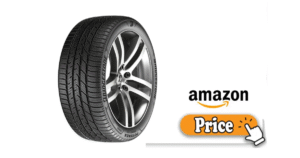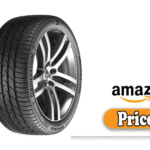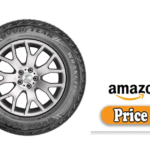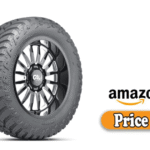Whether you’re driving a compact sedan, an SUV, a performance vehicle, or a rugged pickup truck, tires are one of the most critical components of your vehicle.
They influence everything from fuel efficiency and handling to ride comfort and safety. And when you’re exploring tire brands, Bridgestone almost always comes up, but how much do they cost, and are they worth it?
In this detailed guide, we’ll explore Bridgestone tires’ prices across popular categories, compare them with competitors, break down what you’re paying for, and help you determine whether Bridgestone is the right choice for your next tire purchase.
What I Like About Bridgestone Tires
Bridgestone has been one of the top tire brands worldwide for decades, and for good reason. Here’s what stands out about the brand:
1. Consistent Premium Quality
Bridgestone doesn’t cut corners. Across all its lines, from economy to high-performance, you get well-engineered products backed by thorough research and testing.
2. Advanced Tire Technology
They invest heavily in innovation. Features like Run-Flat Technology, DriveGuard, and Ecopia fuel-saving compounds make Bridgestone a leader in performance and safety.
3. Great Warranty Coverage
Most Bridgestone tires come with generous mileage warranties, ranging from 50,000 to 80,000 miles, depending on the model.
4. Extensive Tire Lineup
No matter what vehicle you drive or what conditions you face, rain, snow, dirt trails, or track day, Bridgestone likely has a tire built for your needs.
5. Wide Availability
Thanks to their global footprint, Bridgestone tires are easy to find in virtually any tire shop, dealership, or online retailer.
What Could Be Better
As much as Bridgestone impresses, there are a few trade-offs to keep in mind, especially when we talk about pricing.
1. High Price Tag
This isn’t a budget brand. Bridgestone tire prices tend to be on the higher side, especially for performance and SUV/truck models.
2. Not Always the Best in Snow
While Bridgestone’s Blizzak series is excellent for winter, their all-season tires, like the Turanza or Ecopia, sometimes underperform in icy or heavy-snow environments compared to brands like Nokian or Michelin.
3. Ride Comfort Varies
Some performance models (like Potenza) sacrifice comfort for responsiveness. While that’s ideal for sport-focused drivers, it may not suit everyone’s preference.
4. Premium Features Mean Premium Costs
Run-flat tires and fuel-efficient tires often carry a steep price tag. You pay extra for the tech, which may not always be necessary for everyday drivers. 👉🏿👉🏻 Check The Latest Price and Offer at Amazon 👈🏻👈🏿
👉🏿👉🏻 Check The Latest Price and Offer at Amazon 👈🏻👈🏿
My Personal Experience
I’ve driven on Bridgestone tires across various vehicle types and terrain conditions, including:
1. 2020 Honda Accord (Turanza QuietTrack)
- Price per tire: ~$185
- Use: Commuting and long highway trips.
- Experience: Impressively quiet and smooth. Fuel economy improved slightly, and the tires wore evenly over 40,000+ miles. Great comfort for daily driving.
2. 2021 Subaru Outback (Dueler H/L Alenza Plus)
- Price per tire: ~$220
- Use: All-season driving with occasional off-road detours.
- Experience: Excellent grip in wet conditions. Highway noise was minimal. The tread held up well after two winters.
3. 2018 BMW 3 Series (Potenza RE980AS)
- Price per tire: ~$200
- Use: Spirited driving and performance commuting.
- Experience: Sticky grip on corners, amazing in dry weather. Some road noise, but the handling was worth it. Expensive, but top-tier performance.
Overall, I’ve found Bridgestone to be a reliable brand with premium build quality, but you pay for it.
Design
Bridgestone puts a ton of effort into the engineering and design of its tires, and it shows.
Tread Patterns
- Asymmetric tread designs for better cornering and grip
- Wide circumferential grooves to reduce hydroplaning
- 3D sipes for improved snow and wet traction
- NanoPro-Tech™ compounds to reduce rolling resistance
Sidewall Aesthetics
Most Bridgestone tires offer clean, modern sidewall branding. Performance lines like Potenza feature more aggressive sidewall patterns, while touring lines like Turanza opt for subtle elegance.
Performance
Performance varies by category, but here’s how Bridgestone tires generally stack up.
1. Dry Traction
Bridgestone excels in dry grip, especially in the Potenza and DriveGuard lines. Whether you’re commuting or carving corners, they’re responsive and confidence-inspiring.
2. Wet Weather
Tires like Turanza QuietTrack and WeatherPeak offer exceptional wet handling thanks to optimized siping and water-evacuation channels.
3. Winter Conditions
The Blizzak series is one of the best-rated winter tire lines. They’re designed to handle extreme snow, slush, and ice. However, their all-season tires may not replace a true winter tire in heavy snow regions.
4. Noise and Ride Comfort
Bridgestone’s touring and eco-friendly tires are tuned for comfort. The Turanza QuietTrack, for example, lives up to its name with reduced road noise.
5. Fuel Efficiency
Ecopia tires are designed with fuel savings in mind, using low rolling resistance compounds to help increase MPG a good choice for hybrids or eco-conscious drivers.
Build Quality
Bridgestone tires are engineered to last, with strict quality control measures in every production facility.
Materials
- Advanced rubber compounds designed for durability and grip
- Steel belts and polyester plies for strength and flexibility
- Proprietary Bridgestone technology like NanoPro-Tech™ for enhanced performance
Manufacturing
Bridgestone operates plants in the U.S., Japan, and around the globe. Their American facilities include locations in Tennessee, Illinois, and North Carolina.
Warranty Coverage
- Touring tires: Up to 80,000 miles
- All-season tires: Typically 50,000 to 70,000 miles
- Performance tires: Around 40,000 to 50,000 miles
- 90-day satisfaction guarantee for most models
Bridgestone Tires Prices: Category Breakdown
Here’s a snapshot of average prices by tire type:
| Tire Model | Category | Average Price (Each) | Best For |
| Turanza QuietTrack | Touring | $170–$220 | Daily commuters, comfort seekers |
| Potenza RE980AS+ | Performance | $190–$250 | Enthusiasts, sports sedans |
| Ecopia EP422 Plus | Eco/Fuel-Saving | $150–$200 | Hybrids, fuel-conscious drivers |
| Dueler H/L Alenza Plus | SUV/All-Season | $200–$260 | SUVs, crossovers, light trucks |
| Blizzak WS90 | Winter | $160–$210 | Snow, ice, winter driving |
Prices vary by size and retailer. You can often find discounts at major online retailers or local tire shops, especially during seasonal sales.
Read More: Goodyear Tires On Sale
Alternative Options
If Bridgestone tire prices are outside your budget or you’re exploring alternatives, here’s how some competing brands compare:
| Brand | Comparable Models | Strengths | Price Tier |
| Michelin | Defender, Pilot Sport | Excellent comfort, long wear | High |
| Continental | TrueContact, ExtremeContact | Strong all-weather grip | Mid-High |
| Goodyear | Assurance, Eagle | Great wet and dry balance | Mid |
| Pirelli | Cinturato, Scorpion | Responsive handling, stylish | Mid-High |
| Firestone | WeatherGrip, Destination | Value-focused, same parent company | Mid |
| Kumho | Ecsta, Solus | Affordable performance | Budget |
Verdict: If performance and reliability matter most, Bridgestone is worth the cost. But brands like Firestone or Kumho offer competitive value at lower price points.
Final Thought
So, what’s the bottom line on Bridgestone tire prices?
Bridgestone is a premium tire brand, and its pricing reflects that. But you’re not just paying for a name, you’re investing in:
- Long tread life
- Advanced safety features
- Superior ride quality
- Trusted performance across seasons
While you’ll likely spend $150–$250 per tire depending on your vehicle and needs, the value comes through in durability, comfort, and peace of mind.
If you’re looking for tires that you can depend on year after year, especially for family vehicles, high-mileage commuters, or performance cars, Bridgestone is an investment worth considering.
FAQs: Bridgestone Tires Prices | My Honest Review
1. Why are Bridgestone tires so expensive?
Bridgestone uses premium materials, advanced technology, and strict manufacturing standards. You pay more for innovation, longevity, and safety features like run-flat capabilities.
2. What is the average price of Bridgestone tires?
Prices typically range from $150 to $250 per tire, depending on size, model, and category.
3. Are Bridgestone tires worth the price?
Yes, especially for drivers seeking long-lasting performance, comfort, and advanced safety. Bridgestone offers a good return on investment over the life of the tire.
4. What’s the best cheap alternative to Bridgestone tires?
Brands like Kumho, General Tire, and Firestone offer solid performance at lower prices. Firestone is also owned by Bridgestone and shares some technology.
5. Do Bridgestone tires go on sale?
Yes! Look for promotions around seasonal changeovers, Black Friday, and manufacturer rebate events. Online retailers often offer better pricing than local stores.
6. How do Bridgestone winter tires compare in price?
Winter tires like Blizzak WS90 range from $160 to $210 each. They’re competitive in price and performance with other top winter tires.
7. Is Bridgestone better than Michelin?
Both are top-tier brands. Michelin often wins in ride comfort and tread life, while Bridgestone shines in performance and all-around durability.
8. Are Bridgestone run-flat tires more expensive?
Yes. Expect to pay $200–$300 per tire for Bridgestone’s DriveGuard series. Run-flat technology adds cost but can eliminate the need for a spare.
9. Where can I buy Bridgestone tires?
They’re available at Discount Tire, Tire Rack, Costco, Bridgestone dealers, and many local mechanics. Prices vary, so it’s worth shopping around.
10. How long do Bridgestone tires last?
Depending on the model, Bridgestone tires last between 50,000 and 80,000 miles under normal driving conditions. Performance tires may wear faster.




